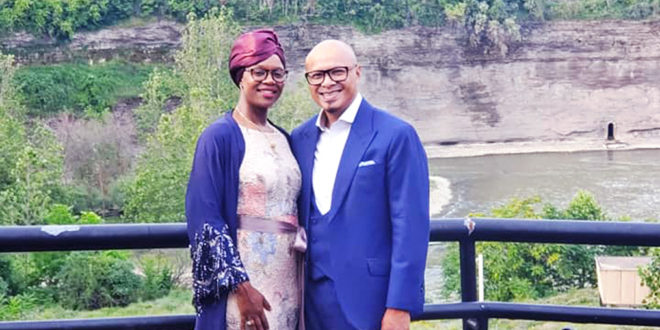Three Syracuse couples share their stories and give tips on how to keep a marriage going strong
According to the Pew Research Center, marriage rates of white adults were roughly 24 percent higher than the marriage rates of Black adults. African-American marriage rates were also lower compared to Asians and Hispanics. But despite statistics, there are plenty of strong marriages in the South Side.
A Pew Forum Religious Landscape survey found shared interests, satisfying sexual relationship, shared household responsibilities, shared religion and having children among the most important attributes of a strong union. The Stand spoke to three South Side couples about the evolution of their relationships and the things that make their marriages thrive.
Looking back on two decades
Emad Rahim and Cjala Surratt had only been dating for a few weeks when she gave him a letter. It detailed the kinds of things she wanted in a man, a relationship and the future she envisioned. It was meant to ensure both were in the same place. She says he grossly misrepresents her one-page as a multi-page “manifesto.”
“I don’t read novels that thick,” Emad joked.
But, it inspired him to buy a wedding ring within the week. He was attracted to her, and slightly intimidated, because she was well-traveled and well-educated.

At the time, he was a struggling student at Onondaga Community College. But he was attentive, which impressed her. For example, one day he surprised her with blueberry pancakes at work because in the span of a long conversation she had mentioned that she enjoyed them.
Reflecting on those early days, it was her bold letter that made him step up. “I was afraid that if she goes back overseas (to study abroad), I’d probably never see her again,” Emad said.
Within a month, they had gone from an awkward set up by friends at a small barbecue to marriage. Their introduction felt so formal: they sat in their friend’s living room but did not speak to each other. Instead Emad’s friend asked Cjala questions and her friend asked him questions, acting as liaisons bridging a language barrier. But once they saw that wasn’t working, they exchanged numbers.
“That’s when we ran up my mother’s phone bill and my brother got very angry because I would never turn over the line,” Cjala said.
Predictably, friends and family thought they were moving too fast. Emad told his mother he was getting married, and she thought it was a joke. She had yet to meet Cjala and missed the wedding because she didn’t believe it was real.
Friends were confused by the idea too because both seemed so different. Although both are Muslim, Cjala came from a middle-class, Black family in the suburbs outside of Syracuse, and Emad was a Cambodian refugee who grew up in poverty and struggled through high school.
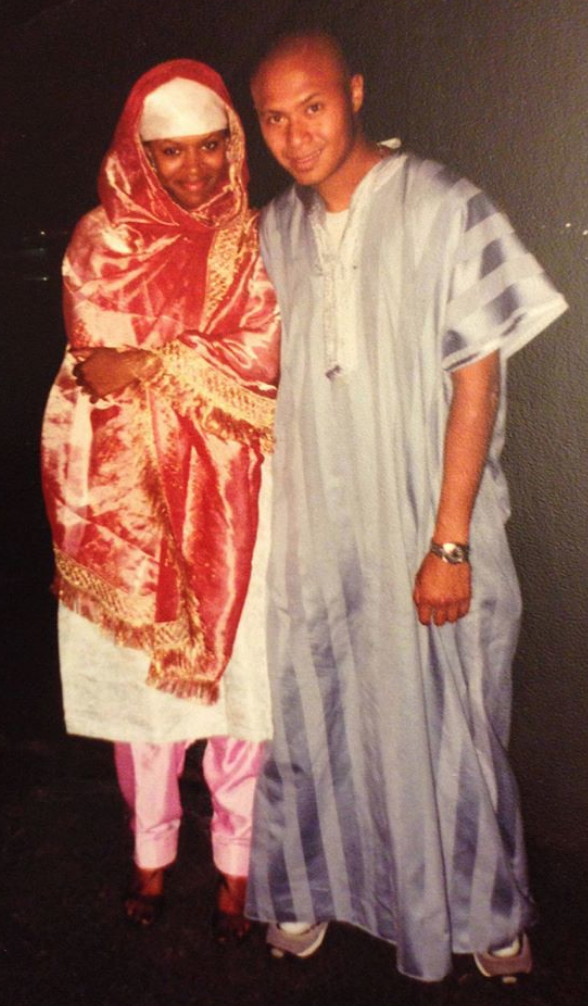
The two look back now and believe they were in “deep juvenile infatuation.” They saw themselves as Romeo and Juliet — it was them against the world. Now, they conceptualize love as “something that withstands something” and their relationship had yet to be tested at that time. But that would soon change.
In the same week of their marriage, their apartment burned down and the newly-weds moved into Cjala’s mom’s unfinished attic. But it happened to be a gift in disguise because it gave her family a chance to know Emad and see that he was committed.
The pair celebrated their 20th anniversary last July. They now have two daughters: Sarhia, 16, who they say is smarter than they are, and Safia, 7, who is a ball of energy. They’ve celebrated successes in education and careers; they’ve lost jobs and struggled over a miscarriage. No matter the hurdle, they’ve jumped together and their love endured it all.
“I think those moments when we’re like, ‘Oh, you’re still here, I’m still here. OK. All right, no one is bailing out of this,’” Cjala began. “Those are the moments where I think this is built on something really strong and profound.”
One of those moments for Cjala was when doctors believed their eldest daughter might have had Downs Syndrome. Although, everything is fine now, the news invoked fear.
“I didn’t know what to do with that emotionally,” Cjala said. “At that time, Emad worked with several different social service agencies that dealt with people who are differently-abled. And he said, ‘All right. That’s what God has given us. And actually, this is the perfect family because I know where all the resources are, I know how to advocate for this child. If this is the child that we have been gifted with. Then we were set.’ I was blown away by that.” —MN
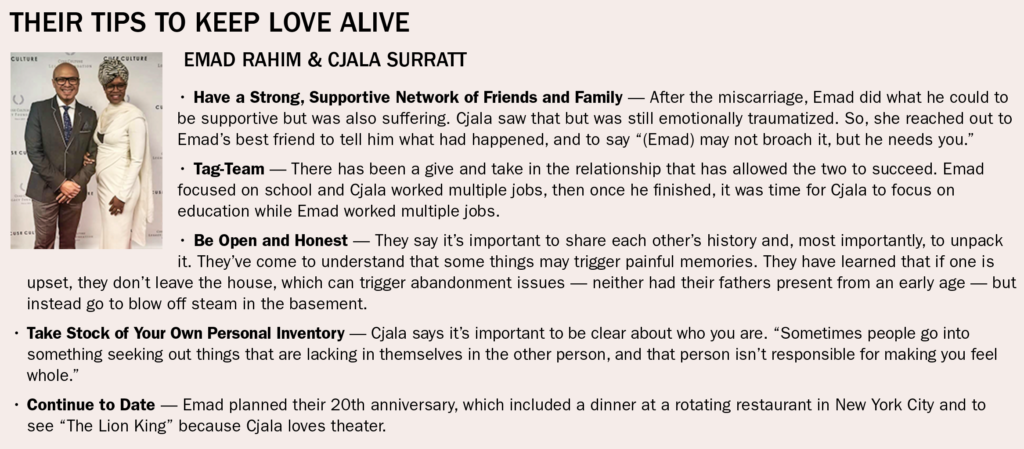
Newlyweds show it’s never too late
If you are wondering if you’ll ever find the right person, you’re not alone. Almost everyone has had this thought at some point. However, don’t despair. Regardless of your age, it’s never too late for love.
Just ask the newlyweds, Maria and Umar Karriem who are 57 and 86 years old, respectively. The South Side couple spoke with The Stand to share how they met and the challenges of marriage.
Maria had been living in Toomey Abbott Towers for about five years before Umar realized that the wife that he had been looking for all these years had finally come. He says he saw her every day, but the distractions of life prevented him from fully recognizing her presence.
Sometimes people can’t see what’s right in front of them because of mental blind spots, called Scotomas, says Alan Akridge, author of “Why We Can’t See What’s in Front of Us.” These blind spots influence our perceptions and determine our reality. So it was with Umar who says, “Satan kept me occupied with other things and not seeing reality.”
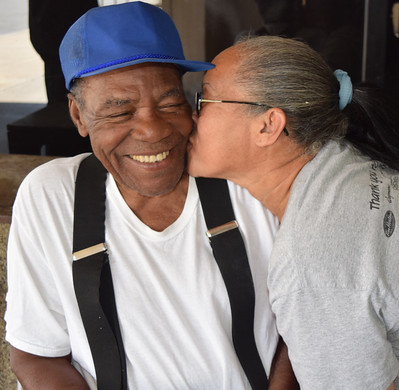
Maria took fate into her own hands and made the first move. One day she walked up to Umar and told him that she had been watching him for some time. She placed a gift, a watch, in his hand and said, “This is for you.”
In some countries, giving a watch or timepiece to your love interest is considered bad luck. In China, for example, receiving or giving a watch is considered a curse. When combined, the two Chinese symbols for “to give” and “watch” mean wake or funeral. Because of this, the gesture of giving a watch became known as “counting down the days” on a relationship, according to Bronya, the author of the article,
“Time Superstitions to Watch Out for This Halloween.” One way to counter this superstition is to offer a small sum, a penny, for the gift. In this way, the watch is actually sold and not given.
But for Maria and Umar, the watch represents the start of a beautiful relationship. That is not to say that they have not faced challenges. Their first challenge: age. People tend to be less pliable as they age and become set in their ways. Second, Umar is Black and Muslim. Maria is Brown ― a Latina ― and Christian. Cross-cultural relationships can bring unique challenges: language barriers, unsupportive families and religious differences.
Through self-sacrifice, commitment and compromise, the couple has overcome their challenges. For example, the marriage ceremony took place July 5, 2019, in Maria’s home church, The New Beginnings Missionary Baptist Church, on Delaware Street. Although Umar says they were actually shooting for July 4, which is the founding of the Nation of Islam (NOI). They were surrounded by a supportive assembly of family members as they exchanged marriage vows.

Umar is no stranger to marriage vows having been married before. He says getting married this time around is the proudest moment in his life because he sees God in their marriage.
“This marriage is the fulfillment of a dream,” he said. “This lady (is) a blessing to me.”
Maria nods her head and says, “I love that man; not important how old he is.” She says Umar is a good husband, father and grandfather, noting that the children love him and call him grandpa.
She confirms how she watched Umar for five years, but he never noticed her. “I saw him before, but he didn’t see me.” She shrugs her shoulders, waves her hand and continues, “it’s not time before; the time is now.”
“Real love comes in the moments―morning, night,” she pauses, “or whatever ― but, it comes no matter what age.” —KM
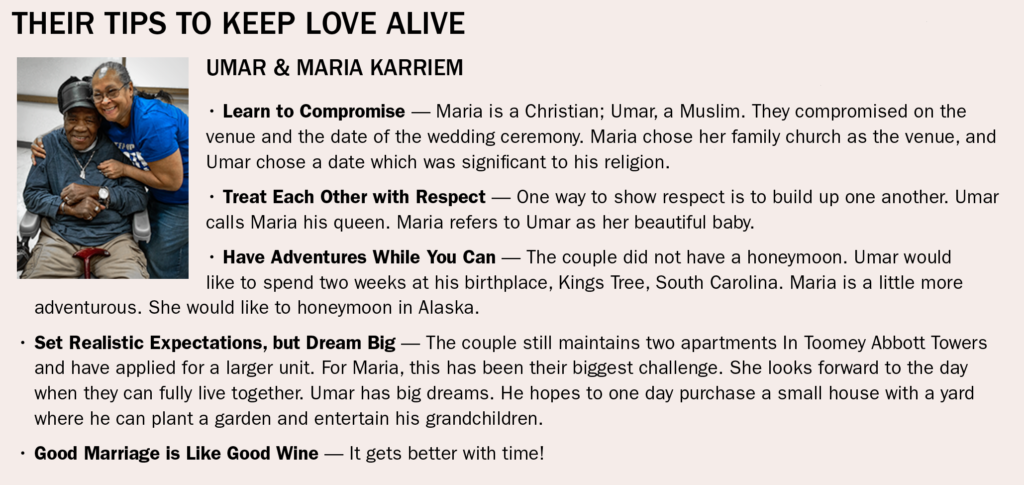
Couple continues to ‘choose’ each other
Joe and Connie Gregory first met at Corcoran High School. She was modeling in a fashion show and he worked as a stagehand. But they began dating years later when they found each other again at Syracuse University. Both had enrolled in the teaching program, which started in the summer.
“I would offer to give her a ride,” Joe said. “And she would say, ‘No, I’ll take the bus,’ for about three or four times. Maybe by the fourth time, she accepted. So that was the start.”
The two began hanging out in Joe’s apartment, talking at the restaurant where Connie worked nights and went to class together every day. Eventually, they spoke about their different family experiences and discussed what they wanted in a marriage. Both valued independence. They would be together because they wanted to be married, not because they had to.

After seeing each other through the summer, discussions turned into a decision. As a devout Christian, Connie’s mother would not approve of her moving in with Joe before they were married. So, in September, they drove to Washington D.C. to elope.
“We started out on a beautiful Sunday morning,” Connie said. “And we drove and then we decided to call my mom. … She was awfully upset. She convinced him that we should come back and have a wedding.”
They came home, and Connie’s mom orchestrated a beautiful candlelit wedding by December, during their next break from school. About 100 friends and family packed into the South Side’s Gospel Temple Church of God in Christ to watch the couple wed after 5 months of dating.

The newly-weds decided that after a year, they would evaluate the relationship to see if that’s what they truly wanted. But a year and a half later, the marriage was treading rocky waters. Joe admits he had some maturing to do.
Then their son Marcus was born. Joe believed his child needed a strong family structure because of his own childhood. His parents had separated when he was 7 and he remembered “needing and wanting to have a father figure.”
“I wanted to be there for him,” Joe said.
He is an avid sports fan and Connie is anything but. She does, however, have strong opinions on education, and the two worked to combine those to instill strong values in their kids, Joe says. Both Marcus, now 44, and their daughter Darien, now 39, were artistic and athletic; Connie says they got those attributes from Joe, who was often their coach.
“They came first during those years,” Connie said.
The couple centered around getting the kids to college and to support them, especially when Darien was sick. She was diagnosed with Stage IV Wilms tumor when she was 11 and needed surgery as well as months of chemo and radiation therapy.
“I really had to be like the general,” Connie said.
She ensured the family kept to their structure to persevere, whether it was school or sports, she wanted to keep things as similar as possible so they wouldn’t fall apart. The support of friends and their faith in Christianity helped as well.
“Prayer has a lot to do with anything that we do,” Connie said.
She notes they also had a strong example in Connie’s parents: John and Audrey Gomez have been married for nearly seven decades. The Gregorys have watched the prototypical couple grow old and continue to care for each other.
Soon the pair faced a new challenge: an empty nest. They needed to decide if they wanted to stay married, or if it would simply be the status quo. At year 23, they again chose to be together because they wanted to, not because they had to.
“We had the conversation about what kind of marriage we want when they’re gone,” Connie said. “]We decided that we wanted to have fun.”
They began taking trips: the Philadelphia Flower Show each year, concerts in Saratoga and visited Frank Lloyd homes outside of Chicago.
Connie says the decision made a big difference because other couples may not know what to do once the kids leave the house and that it gave their marriage direction. “We wanted to keep making the effort for it to be fun,” Connie said. “And to stay together for those reasons rather than just the fact that we’ve been around so long.” —MN
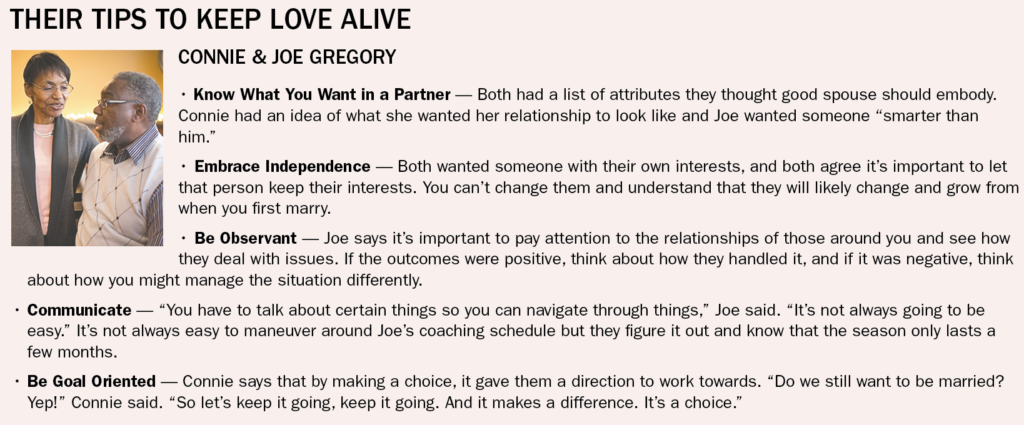
— By Marcus Navarro, The Stand Intern, & Keith Muhammad, The Stand Community Contributor
 The Stand
The Stand

